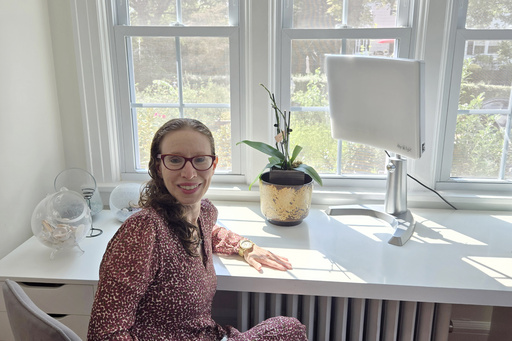
As winter draws near and the days become shorter, individuals who suffer from seasonal depression often experience physical and mental changes.
“It can manifest as a mixture of panic, fear, anxiety, and dread,” shared Germaine Pataki, a 63-year-old resident of Saskatoon, Saskatchewan.
Pataki represents the millions estimated to be affected by seasonal affective disorder (SAD). Her methods of coping include practicing yoga, taking walks, and using prescribed antidepressant medications. She also engages with a supportive Facebook community focused on SAD.
“I concentrate on helping others manage their symptoms, which gives me a sense of purpose,” she explained.
Individuals with SAD typically undergo depressive episodes beginning in the fall and waning in the spring or summer months. The transition to standard time, which takes place this weekend, can serve as a catalyst for the onset of SAD symptoms. Experts also recognize a less severe form known as subsyndromal SAD, and a summertime variant, although there is limited research on this latter type.
The concept of SAD was first introduced in 1984 by Dr. Norman Rosenthal, a researcher affiliated with the National Institutes of Health, who coined the term. “The acronym easily sticks in people’s minds, which is perhaps why it has endured,” he remarked.
What leads to seasonal affective disorder?
Scientists have been investigating how specific cells in our eyes translate blue light wavelengths into neural signals that impact mood and alertness.
Sunlight is rich in blue light; hence, its absorption activates centers in our brains associated with alertness, making us feel more awake and possibly in a better mood.
Research conducted by Kathryn Roecklein at the University of Pittsburgh examined the eye responses to blue light in individuals with and without SAD. The findings indicated that those with SAD exhibited a decreased sensitivity to blue light, particularly during winter.
“In winter months, combined with reduced light levels and lower sensitivity, the exposure may not suffice for optimal functioning, potentially causing depression,” Roecklein stated.
Miriam Cherry, a 50-year-old from Larchmont, New York, shared her experiences as summer winds down, as she prepares for the inevitable dip in her mood. “Every year like clockwork, as daylight fades and the sun sets around 4:45 PM, my spirits inevitably sink,” Cherry noted.
Does light therapy provide relief?
Many individuals suffering from SAD find that light therapy is effective. Dr. Paul Desan from Yale University’s Winter Depression Research Clinic advocates for this treatment, stating, “Light therapy should be the first intervention tried.”
According to Desan, most patients show significant improvement when exposed to bright light for about thirty minutes each morning. In many instances, medications are unnecessary.
This therapy typically utilizes devices that release light about 20 times brighter than standard indoor lighting.
Research has shown that a brightness level of around 10,000 lux is effective, requiring daily exposure for thirty minutes. Desan emphasizes that it can also benefit individuals who experience milder winter mood fluctuations.
Prices for specialized lights range from $70 to $400. However, some products marketed for SAD may be inadequate in brightness, cautioned Desan. Institutions such as Yale evaluate products and provide recommendations, while organizations like the Center for Environmental Therapeutics offer guidance for consumers.
If diagnosed with SAD, individuals are encouraged to consult their insurance providers regarding potential coverage for light therapy expenses, according to Desan.
What is the role of counseling or medication?
Antidepressant medications are commonly used as a standard approach for treating SAD, often in combination with light therapy. Physicians also suggest maintaining a stable sleep routine and engaging in outdoor activities, even under overcast skies.
The effects of light therapy may diminish if the treatment is halted. Cognitive Behavioral Therapy (CBT), a type of talk therapy, has been shown in studies to yield more lasting results, according to Kelly Rohan from the University of Vermont.
CBT assists patients in recognizing and altering unhelpful thought patterns.
“One frequent thought is ‘I despise winter,’” Rohan noted. “Rephrasing it to ‘I prefer summer over winter’ maintains a factual basis while fostering a more neutral mood effect.”
Collaborating with a therapist can empower individuals to gradually engage in enjoyable activities again. Simple pleasures, like meeting a friend for coffee, can help break the cycle of winter hibernation, Rohan suggested.
What other methods might alleviate symptoms?
Those experiencing SAD have half the year to devise coping mechanisms, with some discovering personal techniques that work for them despite limited scientific validation.
Elizabeth Wescott, 69, residing in Folsom, California, swears by contrast showers—an approach adapted from sports medicine—where she alternates between hot and cold water while showering. In addition, she employs a light box and takes antidepressants.
“I’m continuously on the lookout for new methods,” Wescott mentioned.
Similarly, Cherry is cultivating a section of her garden dedicated to early-blooming flora such as snowdrops, winter aconite, and hellebores, which bloom as early as February.
“These flowers symbolize to me that this season won’t last indefinitely,” Cherry expressed. “Things will improve and spring will eventually arrive.”
